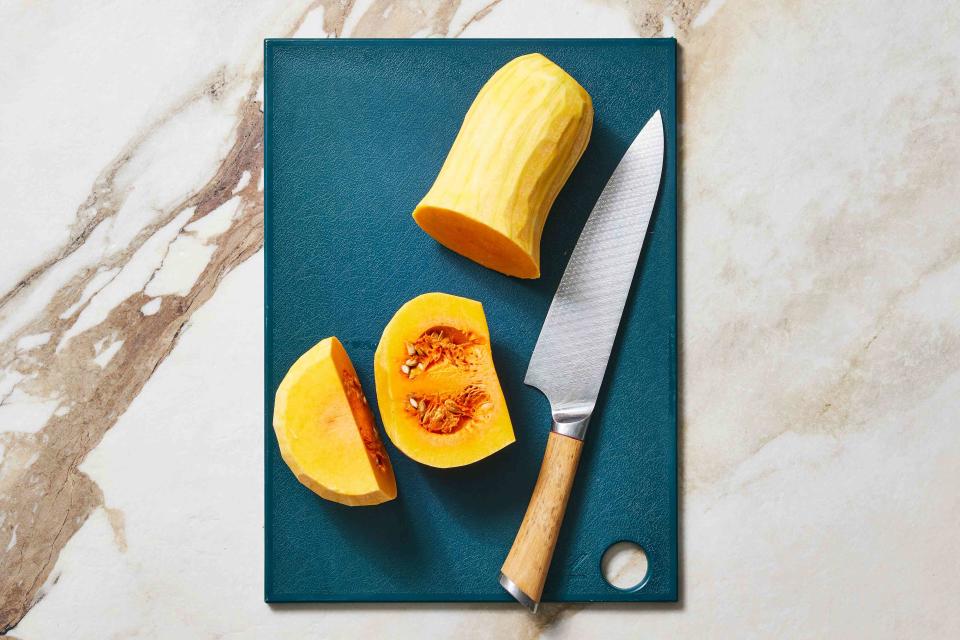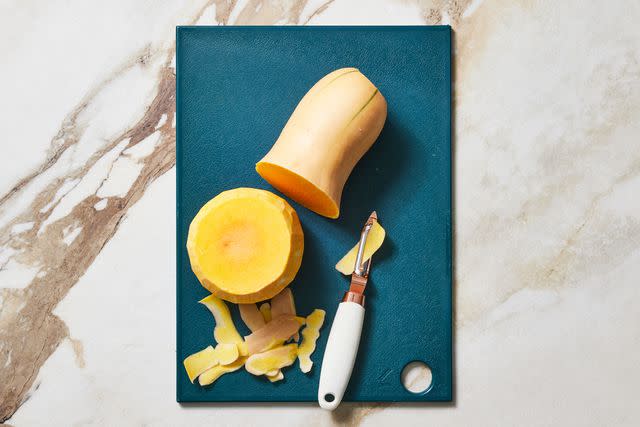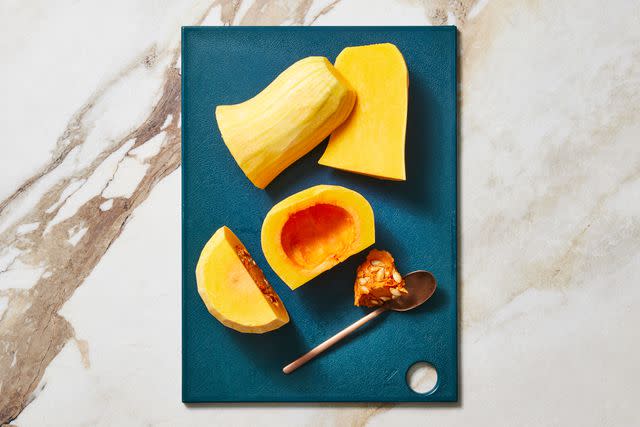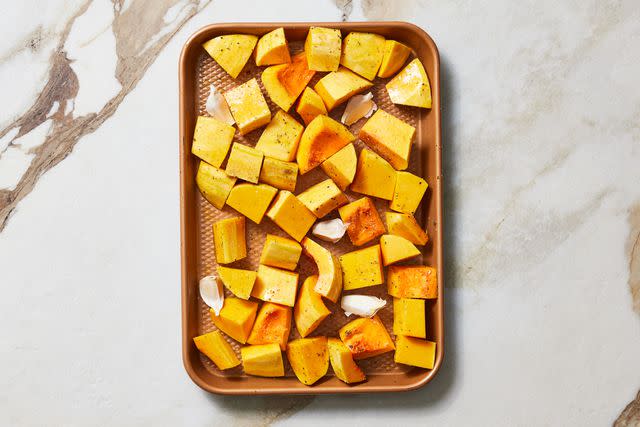How to Cut Butternut Squash the Right Way
Cutting a butternut squash can be tricky—but not if you follow these tips from a chef.

Rachel Marek
Faced with a butternut squash on your cutting board, you might feel excited at the prospect of enjoying the tender, nutty, and sweet roasted squash—but you are likely also intimidated by the journey to get there. How to cut a butternut squash is a cook's dilemma. Handling this large, dense vegetable is definitely no small task, but follow these chef-approved techniques to cut a butternut squash safely.
Meet Our Expert
Olivia Roszkowski is chef-instructor of plant-based culinary arts at the Institute of Culinary Education in New York City
Related: 28 of Our Best Butternut Squash Recipes to Make This Fall
Tools for Cutting and Peeling Butternut Squash

Stable Workspace
A large cutting board is essential to create a safe and effective work station to cut your butternut squash. The next step is stabilizing it, so that the board won't move and slip around while you’re working. A damp paper towel, tea towel, or piece of rubber drawer liner all work well.
Chef's Knife
"A sharp 10- to 12-inch chef's knife is one of the most useful tools to use when cutting a butternut squash," says Olivia Roszkowski, chef-instructor of plant-based culinary arts at the Institute of Culinary Education in New York City. Roszkowski also suggests sharpening your knife, or, if recently sharpened, simply honing it on a honing steel to align the blade before you begin.
Vegetable Peeler
A sharp vegetable peeler is important for preventing slips and drops—a squash landing on your toe is definitely not the desired outcome! Y-style peelers are preferred so you can drag the peeler down the squash instead of pushing the peeler away from you. But use what you feel most comfortable with.
Damp dishcloth
Squash are known to secrete a sap-like residue that is meant to protect their flesh. Unfortunately, it can get on your hands and leave an unpleasant film. To protect your hands, your knife, and your board, keep a hot, damp dishcloth handy to wipe away any sticky residue that appears.
How to Cut, Peel, and Cube Butternut Squash

Rachel Marek
Once you're equipped with the proper tools, there are a few simple steps to peeling and cutting your squash like a pro.
Begin by trimming the ends of the squash with your knife, first using the tip to pierce through the skin. Utilize the knife close to the handle for control and stability.
Steady the squash on your cutting board, or hold it firmly in your hand and peel the squash with your vegetable peeler. "Try short and swift motions with your peeler when peeling butternut squash," says Roszkowski, who suggests shaving any thicker peel with a sharp knife if a vegetable peeler just isn’t cutting it. She also suggests wearing a pair of disposable gloves in case the peeler slips. "Chefs equate this to having an extra layer of skin and can definitely help prevent injury," she says.
Once the squash is peeled, Roszkowski says the best way to handle any butternut squash, especially larger ones, is to cut it in half crosswise first. "This creates a flat and stable surface for it to rest on as you continue to cut it on your cutting board," she says. With the squash lying horizontally on the board, start with just the tip of your knife to enter the flesh halfway from above. Bring the knife down to rest parallel to the board, and then "use the palm of your other hand to help press the knife through the squash while using the strength of your shoulders to apply pressure (as opposed to using your wrist strength) and maintain a firm grip of your knife throughout this process," says Roszkowski.
Take each half of the squash and rest it upright on the board. Cut each half in half lengthwise, revealing the cavity of seeds in the base of the squash. With a large spoon, scoop out the seeds and any fibrous webbing that is unpleasant to eat. Rinse and save the seeds, though! They are a fantastic snack roasted with olive oil and salt.
To cut butternut squash into slices, take each quarter and place it parallel to the cutting board. Cut 1/4-inch or 1/2-inch thick slices crosswise, and prepare for a variety of applications—namely sandwiches, wraps, and salads.
To cut a butternut squash into cubes, take each quarter and place it parallel to the cutting board. Cut it horizontally in 1-inch slices, then again vertically in 1-inch slices, resulting in uniform cubes. "Cubing or slicing a squash is great if you are looking to showcase the shape or you want to obtain a nice caramelization in the oven or in a soup, stew, salad, or tagine," says Roszkowski

Rachel Marek

Rachel Marek
Other Ways to Prepare Butternut Squash
Roasting
If you're looking to puree or liquify the flesh of the squash, there's actually no need to peel before roasting. In fact, the peel helps the cooking process along in a unique way. Once the seeds have been removed, "placing it cut side down on a lined baking tray will allow you to bake it to the point where you can scoop out the flesh," says Roszkowski. "The squash essentially steams in its own shell." She takes advantage of this method for dessert fillings, making butternut squash soup in a blender, butternut squash mash, a topping for shepherd’s pie, or adding it to oatmeal or brownie batter.
Grating
To incorporate squash in a subtle way to risottos, veggie burger mix, meatballs, latkes, or bread doughs, reach for an unexpected piece of equipment: the box grater! Small, thin shreds of squash cook quickly and melt away into any given dish. "It also is a cool effect to add to your next mac and cheese dish because it gives the illusion of unmelted, golden cheddar cheese shreds," says Roszkowski.
Spiralizing
For a low-carb alternative to traditional wheat pasta, Roszkowski suggests using a spiralizer to make your own butternut squash "noodles" at home. They hvae an extra bit of nuttiness and sweetness and become "a fun addition to your next ramen broth or pasta dish," she says.
Read the original article on Martha Stewart.

